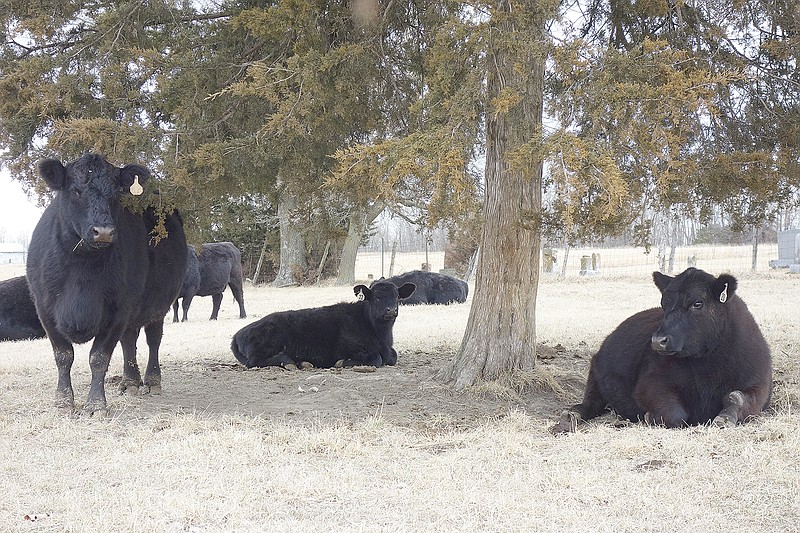A map released Feb. 8 by the National Drought Mitigation Center shows most of Missouri is continuing 2018 as it ended 2017: In a drought.
The drought affects livestock farmers facing dwindling hay reserves. Row crop farmers are eyeing the situation with caution as planting season nears.
"The outlook, it's looking like Missouri should be maintaining a drought status or improving on it a little bit," said Anita Ellis, livestock specialist and Callaway County program director.
The map dissects Callaway County with a line drawn from southwest to northeast. North of that line, the county is in a moderate drought, but the southern triangle is suffering abnormally dry conditions. River bottoms near the Missouri River, however, are slightly better off because of that water source, Ellis said.
East-central, southeastern and south-central Missouri face the largest water deficits in the state.
"Compared to the south part of the state, we're going pretty good," Ellis added.
University of Missouri Extension climatologist Pat Guinan said smaller pockets of long-term dryness also exist over portions of northern Missouri.
"We're still in winter and there is time for notable improvement," Guinan said. "Climatologically, southeast Missouri has the best chance for drought recovery during the cold season."
While concerning, things could be worse. In 1953-54, there were 16 consecutive months of below-normal precipitation, Guinan added. Five years ago, Missouri experienced a severe hydrological drought that carried over from the historic drought of 2012. Conditions improved in February and March 2013, when a much wetter weather pattern emerged. A cool, wet spring followed.
"That being said, drought impacts are currently ongoing," he said.
Missouri just experienced the driest September to January period in more than 40 years, Guinan said. The statewide average precipitation for the period was 8.3 inches - slightly more than half the normal of 15.9 inches.
For the fifth year in a row, Missouri experienced below-normal precipitation in January. Statewide, precipitation for November and December averaged 1.91 inches, or 30 percent of normal.
Ellis said the lack of rainfall last fall will affect the hay and forage growth this spring.
A dry fall doesn't portend a good quality of hay the next spring.
"The new buds will be more stemmy than leafy," Ellis added. "And it's not just growth. The nitrate levels rise, and that's dangerous for animals. In a bad drought, nitrates will build up in plants and harm animals."
There is a test for that, if farmers are in doubt.
"We can do a quick test for nitrate levels in forages," Ellis said.
She added she's met farmers in places such as fairs to test their samples.
Ellis said if a severe drought looks like it's going to happen, she's happy to work with farmers to make early plans.
"The best time to make a plan is before we hit a drought: When it's raining," she said, laughing. "If there's a high drought, it may be more feasible to sell off some animals - although you need to consider tax ramifications. I've had to work with producers before. Do I sell? Which ones do I sell? There's a lot of factors."
So far this winter, local farmers haven't voiced concerns about drought conditions with Ellis. However, maybe they should start thinking about the "what ifs?"
"Clearly, we are in a dry spell. It's not going to be very good for our hay crop or pastures," she added. "But this could be an opportunity for those farmers who do sell of inventory to be more strict on their genetics."
Last year, some parts of Missouri began experiencing dry spells in June. However, by the end of 2017, the current drought affected much of the state, with parts showing a rainfall deficit of a foot or more, Guinan said.
At Prairie Fork, rainfall in June 2015 totaled 9.59 inches. In 2016, it was 1.3 inches, and 4.06 in 2017, slightly better but less than half as much as in June 2015.
Overall, rainfall at Prairie Fork totaled 48.6 inches in 2015, 40.68 in 2016 and then dropped to 36.95 in 2017.
MU Extension specialists from east-central, southeastern and south-central Missouri reported drought impacts to Guinan in the fall. These impacts persist.
They reported failures of fall-sown crops, including wheat, to germinate. Annuals such as oats and turnips did not produce well, and new grass and legume seedlings were reported in poor condition.
Dry conditions also led to large numbers of brush and grass fires, said MU Extension natural resources engineer Frank Wideman, whose office is in Perryville, 80 miles south of St. Louis. Perry County was one of several counties in the state to issue burn bans.
Livestock owners in drought-stricken areas continue to face concerns about dwindling hay supplies before spring grasses appear.
"Producers who need hay and don't yet have it tied down are looking out of the area and are probably going to have to pay higher than normal prices," said Ted Probert, MU Extension dairy specialist in Wright County in southwestern Missouri.
Because of dry conditions, farmers started feeding hay earlier in the season than normal, Probert said.
"Much of the hay put up last spring was cut late and quality is not good," he added.
Feeding low-quality hay for longer than normal may adversely affect the condition of animals as they come out of winter, he said.
How to help
Guinan encouraged Missourians to participate in the drought assessment process and submit information to the Drought Mitigation Center's Drought Impact Reporter at droughtreporter.unl.edu/map. For more information on how to submit information, visit climate.missouri.edu/news/arc/july2017b.php.
The center's Drought Monitor Map collects data from numerous agencies.
Guinan suggests the following resources for those following Missouri's drought conditions:
National Drought Mitigation Center's Drought Impact Reporter, droughtreporter.unl.edu/map.
Drought Monitor Map for Missouri, droughtmonitor.unl.edu/CurrentMap/StateDroughtMonitor.aspx?MO.
Community Collaborative Rain, Hail and Snow Network (CoCoRaHS) Condition Monitoring Map, www.cocorahs.org/Maps/conditionmonitoring.

